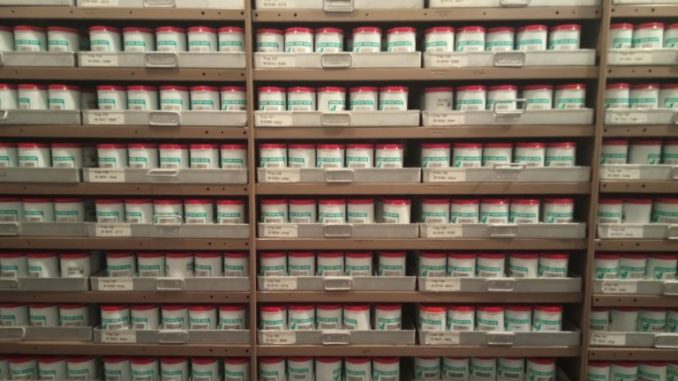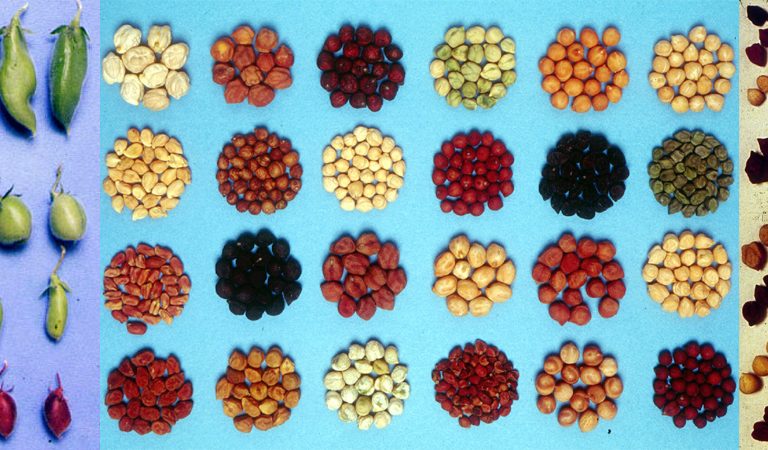
- The ICRISAT Genebank in Telangana serves as a global repository for the collection of germplasm of six mandate crops (crops assigned to ICRISAT for research): sorghum, pearl millet, chickpea, pigeonpea, groundnut, finger millet; and five small millets: foxtail millet, little millet, kodo millet, proso millet and barnyard millet.
- The genebank hosts 126,830 accessions (samples of a particular plant/crop population stored as seeds) collected from 144 countries. It is one of the largest such international repositories of plant genetic material.
- The collection of raw genetic material is needed to breed diverse crops to ensure food security in an increasingly uncertain environment.
- Now, new projects are being rolled out to secure and bolster the collection of the genebank, identify gap areas and enhance its usability.
Stashed away in earthquake proof and environment-controlled vaults in south India, are thousands of stockpiles of seeds of crops important to semi-arid tropics covering Asia, much of southern and eastern Africa, and a few locations in Latin America.
This fortified archive at the International Crops Research Institute for the Semi-Arid Tropics (ICRISAT) headquarters at Patancheru near Hyderabad in Telangana, is home to one of the largest plant genebanks in the world – a safehouse with rows of neatly labelled cans and vacuum sealed aluminium foil packs containing seeds.
And for over four decades, the R.S. Paroda genebank at ICRISAT has been working quietly to preserve bounties of crop diversity watched over by expert genebank managers.
The collection of raw genetic material is needed to breed diverse crops to ensure food security, as environmental degradation, climate change and desertification in dryland areas threaten food production and security.
The genebank hosts 126,830 accessions (samples of a particular plant population stored as seeds) collected and assembled from 144 countries, including the world’s largest genetic holdings of sorghum, pearl millet chickpea, pigeonpea, groundnut and small millets.

Now, new projects are being rolled out to secure and bolster the collection of the genebank, identify gap areas and enhance its usability.
“If we don’t have germplasm we don’t have the basis to develop anything. So all the breeding programmes and research on these crops are based on germplasm and the genebank represents the biggest diversity possible of all those crops so we can have variability. Our job is to generate data so we can improve the utility of the bank,” Vania Azevedo, head of the ICRISAT Genebank, told Mongabay-India.
Fewer crops feeding the world (less diversity) than 50 years ago, renders agriculture more vulnerable to stresses such as droughts, insect pests and diseases. Having more diversity means having access to a large range of genetic traits.
“This diversity aids farmers adapt their crops to provide protection from disease, insect pests and changes in the climate. Some crops that were not important 50 years ago may become important in the future as we witness a change in climate. So genebanks are important toolkits in adaptation,” Hari Upadhyaya, principal scientist, ICRISAT Genebank, told Mongabay-India.
This long-term storage of seeds is, therefore, envisioned as a strategy to salvage crop diversity.
“By drying and freezing, the lifespan of the seeds can be extended to the order of decades and even centuries. Because of the diversity, researchers and farmers tap into this collection as a source for tolerance to diseases and insect pests, environmental stresses, higher nutritional quality and traits related to yield for crop improvement,” Upadhyaya, said.
Several germplasm accessions, conserved as active and base collection in the genebank, are as old as 45 years (1974-75 post-rainy season harvests), Upadhyaya said.

These accessions have taken centre stage in breakthrough work on plants for food, fodder and energy.
One of the best examples illustrating the harnessing of plant genetic resources used by breeders, returned to farmers and offered to consumers is the direct release of ICP 8863, a pigeopea germplasm line, from the genebank.
It was released in 1986 as “Maruti” for cultivation in Karnataka and later on in Maharashtra and Andhra Pradesh.
“ICP 8863, a pigeonpea germplasm line was found to be very promising against fusarium wilt and high yielding. The value of benefit from ICP 8863 has been estimated at US $ 61.7 million by 1996 with 65 percent internal rate of return,” Upadhyaya said.
Beyond borders
The key activities of the genebank range from characterisation, regeneration and viability testing, followed by duplication of the accessions. However, Azevedo said, maintaining the flow of the genetic resources from country to country, across continents, aids in giving a fillip to food security.
ICRISAT’s genetic repository is also helping make crop diversity usable through research for countries across the world facilitated by the International Treaty on Plant Genetic Resources for Food and Agriculture (ITPGRFA), a legally binding instrument that provides a multilateral legal framework to facilitate exchange of plant genetic resources.
Majority of the ICRISAT genebank collection is placed in trust with the (ITPGRFA) for use by the global community as International Public Good (IPG).

The genebank is one among the 11 genebanks located globally at CGIAR (Consortium of International Agricultural Research Centres) a 15-institution partnership system of research organisations working towards food security. .
About 35.5 percent of accessions in ICRISAT genebank are of India-origin.
The genebank has promoted testing and release of 107 accessions directly as 143 cultivars in 53 countries through national partners, revealed Upadhyaya. These are spread across all the continents: 67 cultivars in Africa, 54 in Asia, 11 in Americas, nine in Europe and two in Oceania.
A ‘black box’ of seeds
So “priceless” are these accessions that as a backup, the genebank’s collections have been duplicated and tucked away safely at the Svalbard Global Seed Vault, often referred to as the “Bank of last resort”. Located under permafrost in Svalbard island (part of Norway) in the Artic Ocean, this storehouse of seeds collected from such genebanks across the world is also called as the Doomsday Vault. It is meant to be used to restart agriculture if natural or manmade disasters were to destroy agriculture in different parts of the world.
Azevedo cites the case of the International Center for Agricultural Research in the Dry Areas or ICARDA to buttress her point. With the escalation of the Syrian civil war, ICARDA was forced to evacuate its headquarters in Aleppo where its genebank sheltered 150,000 cereal, food and feed samples from more than 100 countries.
Due to the conflict in Syria, ICARDA in 2015 became “the first genebank to withdraw seeds from their deposit in Svalbard Global Seed Vault.”
ICARDA lost the gene bank in Aleppo but they had a copy in Svalbard so they were able to secure their collections.
“Our collection is already duplicated there and all the material that is there is under the treaty. About 111,000 accessions we have duplicated there, all the FAO designated accessions and this duplication is like a black box. The packages are sealed and no one, other than ICRISAT can open them,” Azevedo said.

And the hunt is on for a second “black box” as under the CGIAR, two duplicate sets should be maintained. The Brazilian Agricultural Research Corporation (EMBRAPA) genebank is a strong contender, Azevedo believes.
“I think it is a good partnership and we can also receive their collection as a black box. This is something we can do especially when we are asking people to do it for us,” she said.
Next up is attaching molecular characterisation to the regular characterisation (description of the germplasm) paving the way for developing thematic core collections.
“So it helps identify small groups of accessions that are interesting for being used in breeding programmes such as for drought and heat tolerance. Then we can have different sets of groups of accessions inside the gene bank,” Azevedo explained.
Each accession is now being accorded a globally unique and permanent identifier or Digital Object Identifiers (DOI or standardised alphanumeric string) just as is done for published research.
“This information guarantees that this seed you have, came from this accession and you can be sure about the origin of the material you are working with in case you want to go back to the parental material.” she said.
Azevedo and colleagues are also excited pinpointing the gap areas: areas from which no collections have been made till date. “Based on the data of the material that we have already collected we can identify where in the world this germplasm was collected. Based on information about the centre of origin and probability of the area of occurrence of this species we can identify areas from where this material was never collected. This is what we call our gap areas,” she said.
A 2015 Food and Agricultural Organisation report called “Coping with climate change: The roles of genetic resources for food and agriculture,” suggests that collections cover the full geographic range of the targeted species, especially populations found at the extremes of the species’ distributions, where novel traits may be found.
“As wild species are generally more vulnerable than domesticated species to the threats associated with climate change, they should be priorities for collection. As climate change proceeds, it is likely that a broader range of species will need to be exchanged between countries and regions,” the report said.
The report also emphasised that it will be important to ensure that these genetic resources can be accessed fairly and equitably by those who need them.
“We know everywhere wild areas and native forests are disappearing so this ex situ conservation as we call the genebank can complement this in situ (on site) conservation,” Azevedo signed off.

Source: Mongabay-India

Leave a Reply